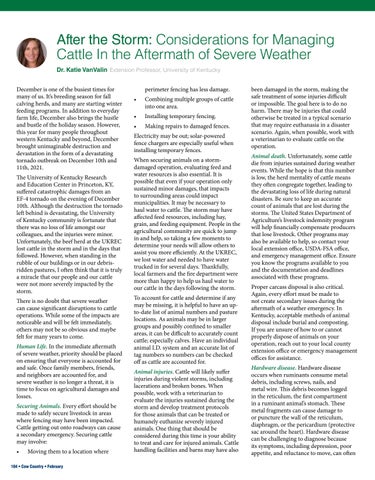After the Storm: Considerations for Managing Cattle In the Aftermath of Severe Weather Dr. Katie VanValin Extension Professor, University of Kentucky December is one of the busiest times for many of us. It’s breeding season for fall calving herds, and many are starting winter feeding programs. In addition to everyday farm life, December also brings the hustle and bustle of the holiday season. However, this year for many people throughout western Kentucky and beyond, December brought unimaginable destruction and devastation in the form of a devastating tornado outbreak on December 10th and 11th, 2021. The University of Kentucky Research and Education Center in Princeton, KY, suffered catastrophic damages from an EF-4 tornado on the evening of December 10th. Although the destruction the tornado left behind is devastating, the University of Kentucky community is fortunate that there was no loss of life amongst our colleagues, and the injuries were minor. Unfortunately, the beef herd at the UKREC lost cattle in the storm and in the days that followed. However, when standing in the rubble of our buildings or in our debrisridden pastures, I often think that it is truly a miracle that our people and our cattle were not more severely impacted by the storm. There is no doubt that severe weather can cause significant disruptions to cattle operations. While some of the impacts are noticeable and will be felt immediately, others may not be so obvious and maybe felt for many years to come. Human Life. In the immediate aftermath of severe weather, priority should be placed on ensuring that everyone is accounted for and safe. Once family members, friends, and neighbors are accounted for, and severe weather is no longer a threat, it is time to focus on agricultural damages and losses. Securing Animals. Every effort should be made to safely secure livestock in areas where fencing may have been impacted. Cattle getting out onto roadways can cause a secondary emergency. Securing cattle may involve: •
Moving them to a location where
104 • Cow Country • February
perimeter fencing has less damage. •
Combining multiple groups of cattle into one area.
•
Installing temporary fencing.
•
Making repairs to damaged fences.
Electricity may be out; solar-powered fence chargers are especially useful when installing temporary fences. When securing animals on a stormdamaged operation, evaluating feed and water resources is also essential. It is possible that even if your operation only sustained minor damages, that impacts to surrounding areas could impact municipalities. It may be necessary to haul water to cattle. The storm may have affected feed resources, including hay, grain, and feeding equipment. People in the agricultural community are quick to jump in and help, so taking a few moments to determine your needs will allow others to assist you more efficiently. At the UKREC, we lost water and needed to have water trucked in for several days. Thankfully, local farmers and the fire department were more than happy to help us haul water to our cattle in the days following the storm. To account for cattle and determine if any may be missing, it is helpful to have an upto-date list of animal numbers and pasture locations. As animals may be in larger groups and possibly confined to smaller areas, it can be difficult to accurately count cattle; especially calves. Have an individual animal I.D. system and an accurate list of tag numbers so numbers can be checked off as cattle are accounted for. Animal injuries. Cattle will likely suffer injuries during violent storms, including lacerations and broken bones. When possible, work with a veterinarian to evaluate the injuries sustained during the storm and develop treatment protocols for those animals that can be treated or humanely euthanize severely injured animals. One thing that should be considered during this time is your ability to treat and care for injured animals. Cattle handling facilities and barns may have also
been damaged in the storm, making the safe treatment of some injuries difficult or impossible. The goal here is to do no harm. There may be injuries that could otherwise be treated in a typical scenario that may require euthanasia in a disaster scenario. Again, when possible, work with a veterinarian to evaluate cattle on the operation. Animal death. Unfortunately, some cattle die from injuries sustained during weather events. While the hope is that this number is low, the herd mentality of cattle means they often congregate together, leading to the devastating loss of life during natural disasters. Be sure to keep an accurate count of animals that are lost during the storms. The United States Department of Agriculture’s livestock indemnity program will help financially compensate producers that lose livestock. Other programs may also be available to help, so contact your local extension office, USDA-FSA office, and emergency management office. Ensure you know the programs available to you and the documentation and deadlines associated with these programs. Proper carcass disposal is also critical. Again, every effort must be made to not create secondary issues during the aftermath of a weather emergency. In Kentucky, acceptable methods of animal disposal include burial and composting. If you are unsure of how to or cannot properly dispose of animals on your operation, reach out to your local county extension office or emergency management offices for assistance. Hardware disease. Hardware disease occurs when ruminants consume metal debris, including screws, nails, and metal wire. This debris becomes logged in the reticulum, the first compartment in a ruminant animal’s stomach. These metal fragments can cause damage to or puncture the wall of the reticulum, diaphragm, or the pericardium (protective sac around the heart). Hardware disease can be challenging to diagnose because its symptoms, including depression, poor appetite, and reluctance to move, can often






















